Construction and Property Law Memorandum of Advice - Liabilities
VerifiedAdded on 2021/04/17
|13
|2465
|67
Report
AI Summary
This memorandum of advice analyzes potential liabilities arising from a construction project involving the NSW Government, AllTrack, and Von Fimerick. It examines claims related to contract law, including liquidated damages for delays and inferior quality materials, and tort law, specifically negligence, concerning injuries to Tom and Bob. The analysis considers the roles and responsibilities of each party, including the subcontractor, and assesses the likelihood of successful claims. The memorandum also discusses the application of legal principles such as contributory negligence and the impact of the letter of intent. The document concludes that the NSW Government can claim damages from AllTrack and Von Fimerick, and that AllTrack can claim from Von Fimerick. It also concludes that Tom can claim for negligence against NSW Government, but his damages will be reduced due to contributory negligence, and that Bob can claim for psychiatric illness.
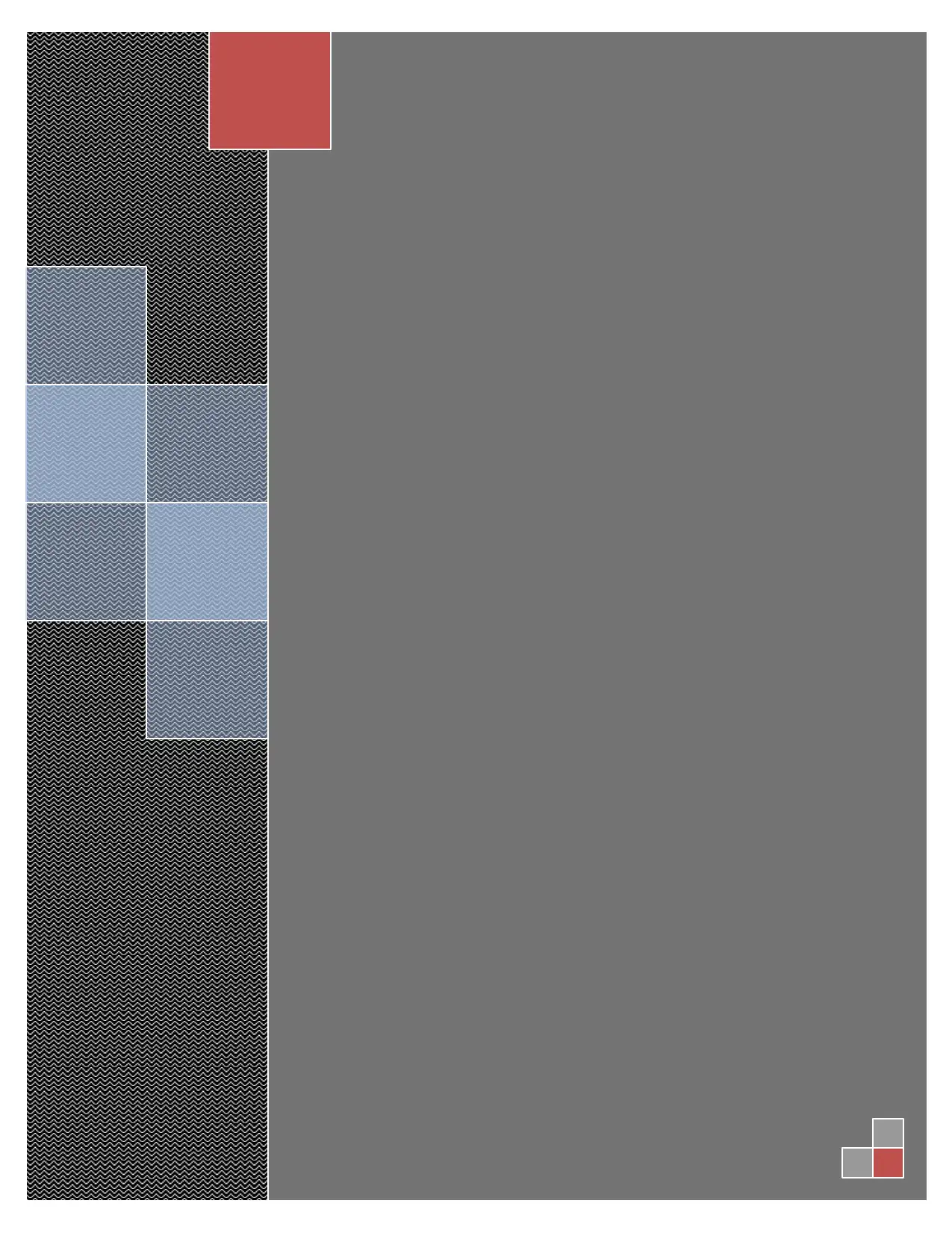
Paraphrase This Document
Need a fresh take? Get an instant paraphrase of this document with our AI Paraphraser
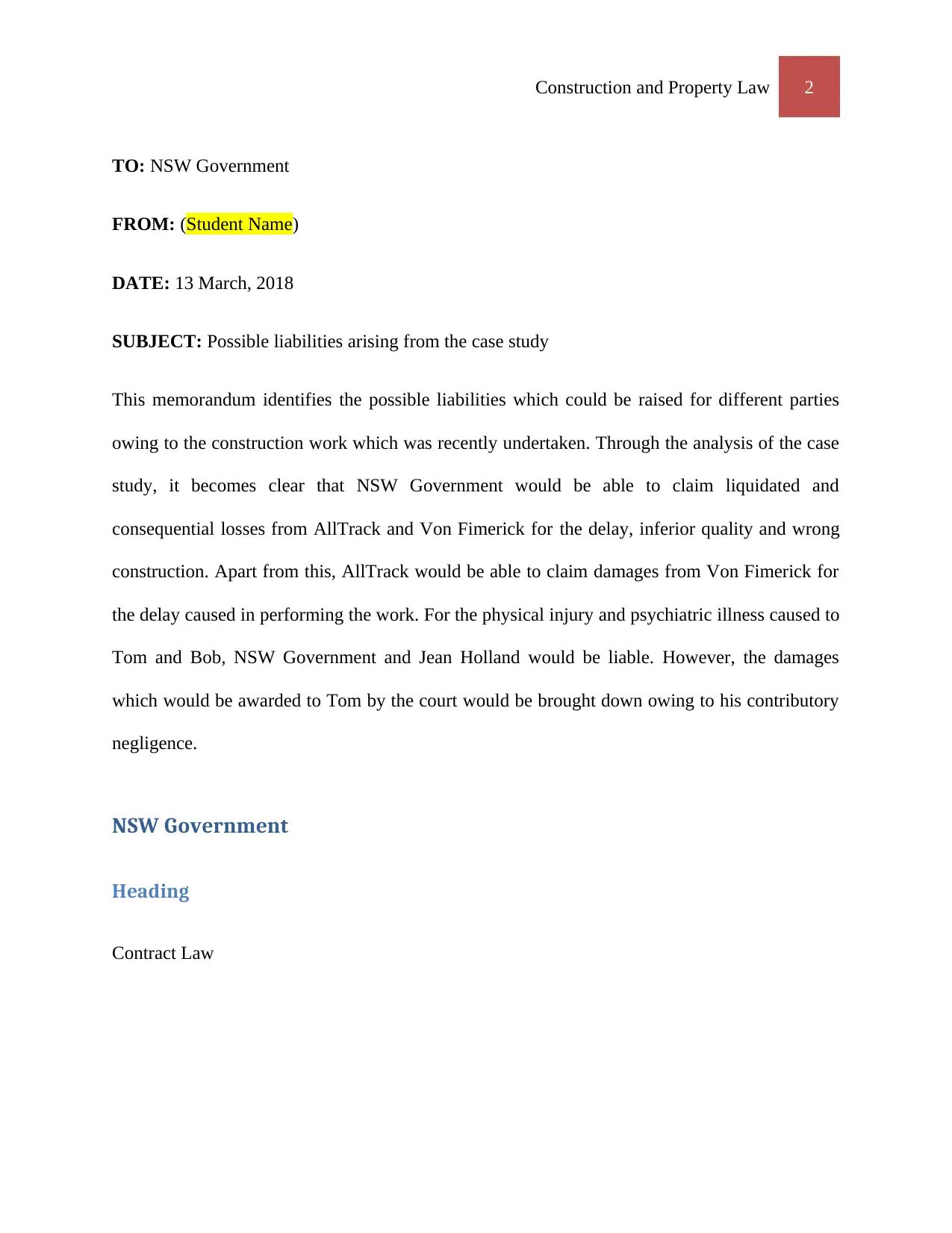
Construction and Property Law 2
TO: NSW Government
FROM: (Student Name)
DATE: 13 March, 2018
SUBJECT: Possible liabilities arising from the case study
This memorandum identifies the possible liabilities which could be raised for different parties
owing to the construction work which was recently undertaken. Through the analysis of the case
study, it becomes clear that NSW Government would be able to claim liquidated and
consequential losses from AllTrack and Von Fimerick for the delay, inferior quality and wrong
construction. Apart from this, AllTrack would be able to claim damages from Von Fimerick for
the delay caused in performing the work. For the physical injury and psychiatric illness caused to
Tom and Bob, NSW Government and Jean Holland would be liable. However, the damages
which would be awarded to Tom by the court would be brought down owing to his contributory
negligence.
NSW Government
Heading
Contract Law
TO: NSW Government
FROM: (Student Name)
DATE: 13 March, 2018
SUBJECT: Possible liabilities arising from the case study
This memorandum identifies the possible liabilities which could be raised for different parties
owing to the construction work which was recently undertaken. Through the analysis of the case
study, it becomes clear that NSW Government would be able to claim liquidated and
consequential losses from AllTrack and Von Fimerick for the delay, inferior quality and wrong
construction. Apart from this, AllTrack would be able to claim damages from Von Fimerick for
the delay caused in performing the work. For the physical injury and psychiatric illness caused to
Tom and Bob, NSW Government and Jean Holland would be liable. However, the damages
which would be awarded to Tom by the court would be brought down owing to his contributory
negligence.
NSW Government
Heading
Contract Law
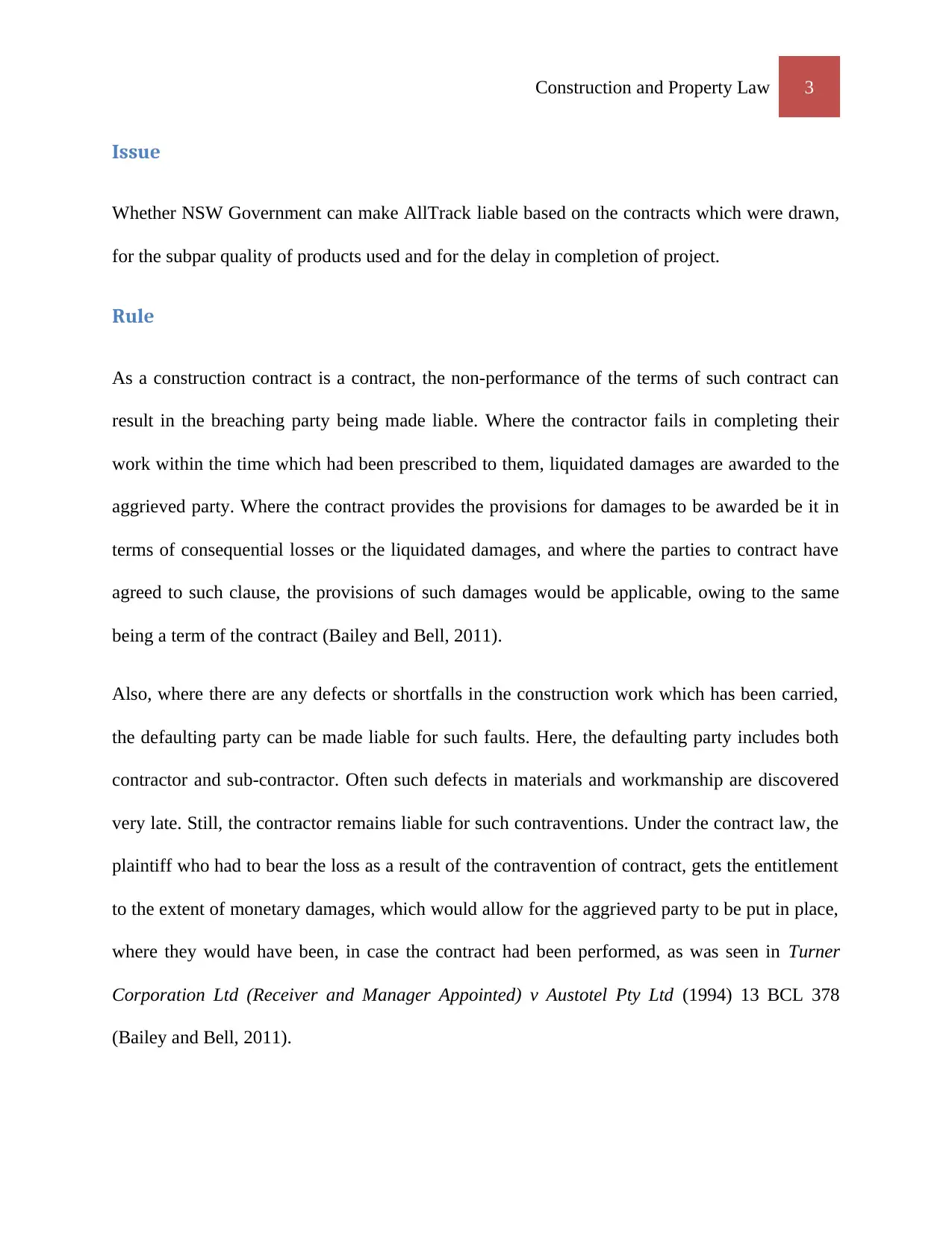
Construction and Property Law 3
Issue
Whether NSW Government can make AllTrack liable based on the contracts which were drawn,
for the subpar quality of products used and for the delay in completion of project.
Rule
As a construction contract is a contract, the non-performance of the terms of such contract can
result in the breaching party being made liable. Where the contractor fails in completing their
work within the time which had been prescribed to them, liquidated damages are awarded to the
aggrieved party. Where the contract provides the provisions for damages to be awarded be it in
terms of consequential losses or the liquidated damages, and where the parties to contract have
agreed to such clause, the provisions of such damages would be applicable, owing to the same
being a term of the contract (Bailey and Bell, 2011).
Also, where there are any defects or shortfalls in the construction work which has been carried,
the defaulting party can be made liable for such faults. Here, the defaulting party includes both
contractor and sub-contractor. Often such defects in materials and workmanship are discovered
very late. Still, the contractor remains liable for such contraventions. Under the contract law, the
plaintiff who had to bear the loss as a result of the contravention of contract, gets the entitlement
to the extent of monetary damages, which would allow for the aggrieved party to be put in place,
where they would have been, in case the contract had been performed, as was seen in Turner
Corporation Ltd (Receiver and Manager Appointed) v Austotel Pty Ltd (1994) 13 BCL 378
(Bailey and Bell, 2011).
Issue
Whether NSW Government can make AllTrack liable based on the contracts which were drawn,
for the subpar quality of products used and for the delay in completion of project.
Rule
As a construction contract is a contract, the non-performance of the terms of such contract can
result in the breaching party being made liable. Where the contractor fails in completing their
work within the time which had been prescribed to them, liquidated damages are awarded to the
aggrieved party. Where the contract provides the provisions for damages to be awarded be it in
terms of consequential losses or the liquidated damages, and where the parties to contract have
agreed to such clause, the provisions of such damages would be applicable, owing to the same
being a term of the contract (Bailey and Bell, 2011).
Also, where there are any defects or shortfalls in the construction work which has been carried,
the defaulting party can be made liable for such faults. Here, the defaulting party includes both
contractor and sub-contractor. Often such defects in materials and workmanship are discovered
very late. Still, the contractor remains liable for such contraventions. Under the contract law, the
plaintiff who had to bear the loss as a result of the contravention of contract, gets the entitlement
to the extent of monetary damages, which would allow for the aggrieved party to be put in place,
where they would have been, in case the contract had been performed, as was seen in Turner
Corporation Ltd (Receiver and Manager Appointed) v Austotel Pty Ltd (1994) 13 BCL 378
(Bailey and Bell, 2011).
⊘ This is a preview!⊘
Do you want full access?
Subscribe today to unlock all pages.

Trusted by 1+ million students worldwide
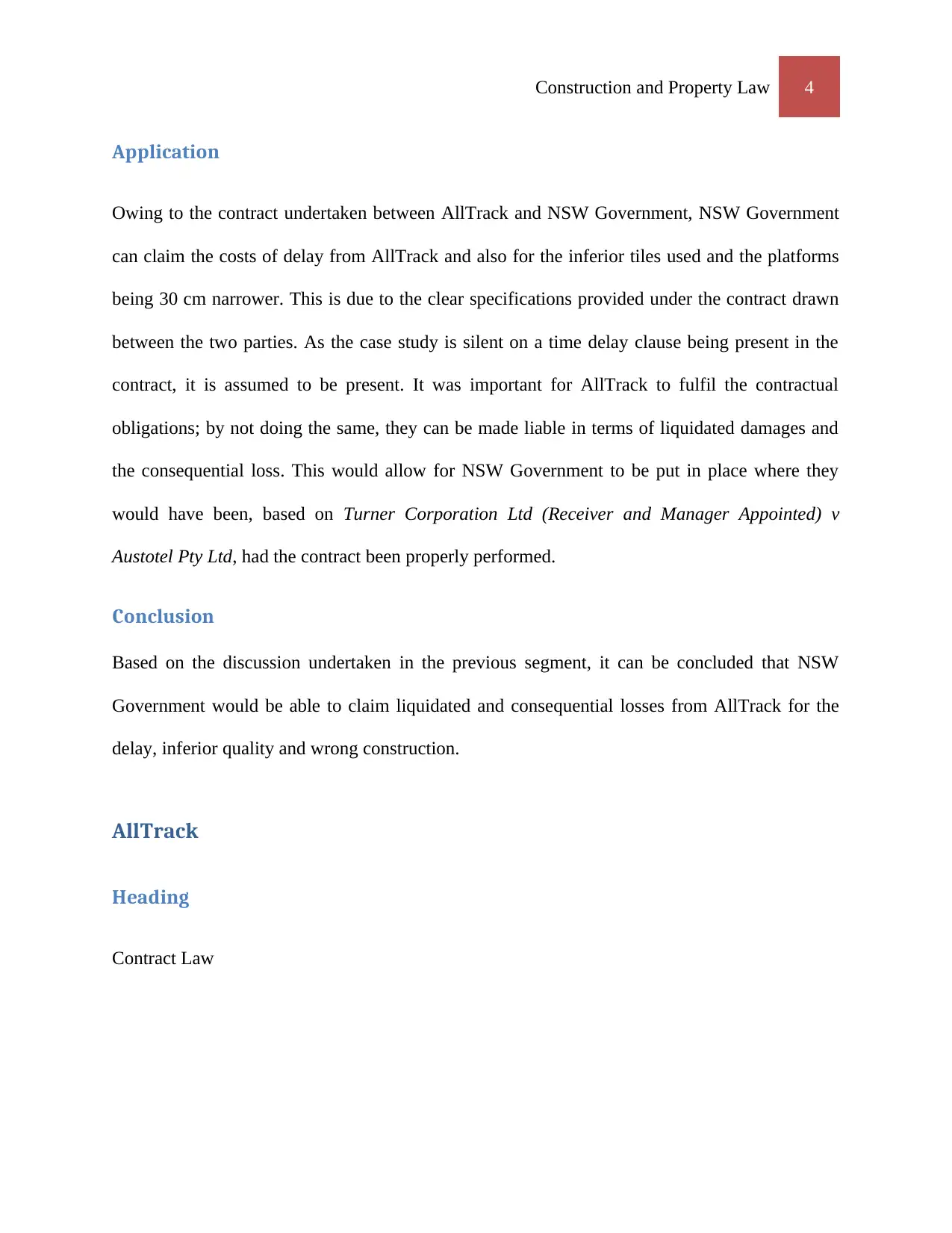
Construction and Property Law 4
Application
Owing to the contract undertaken between AllTrack and NSW Government, NSW Government
can claim the costs of delay from AllTrack and also for the inferior tiles used and the platforms
being 30 cm narrower. This is due to the clear specifications provided under the contract drawn
between the two parties. As the case study is silent on a time delay clause being present in the
contract, it is assumed to be present. It was important for AllTrack to fulfil the contractual
obligations; by not doing the same, they can be made liable in terms of liquidated damages and
the consequential loss. This would allow for NSW Government to be put in place where they
would have been, based on Turner Corporation Ltd (Receiver and Manager Appointed) v
Austotel Pty Ltd, had the contract been properly performed.
Conclusion
Based on the discussion undertaken in the previous segment, it can be concluded that NSW
Government would be able to claim liquidated and consequential losses from AllTrack for the
delay, inferior quality and wrong construction.
AllTrack
Heading
Contract Law
Application
Owing to the contract undertaken between AllTrack and NSW Government, NSW Government
can claim the costs of delay from AllTrack and also for the inferior tiles used and the platforms
being 30 cm narrower. This is due to the clear specifications provided under the contract drawn
between the two parties. As the case study is silent on a time delay clause being present in the
contract, it is assumed to be present. It was important for AllTrack to fulfil the contractual
obligations; by not doing the same, they can be made liable in terms of liquidated damages and
the consequential loss. This would allow for NSW Government to be put in place where they
would have been, based on Turner Corporation Ltd (Receiver and Manager Appointed) v
Austotel Pty Ltd, had the contract been properly performed.
Conclusion
Based on the discussion undertaken in the previous segment, it can be concluded that NSW
Government would be able to claim liquidated and consequential losses from AllTrack for the
delay, inferior quality and wrong construction.
AllTrack
Heading
Contract Law
Paraphrase This Document
Need a fresh take? Get an instant paraphrase of this document with our AI Paraphraser
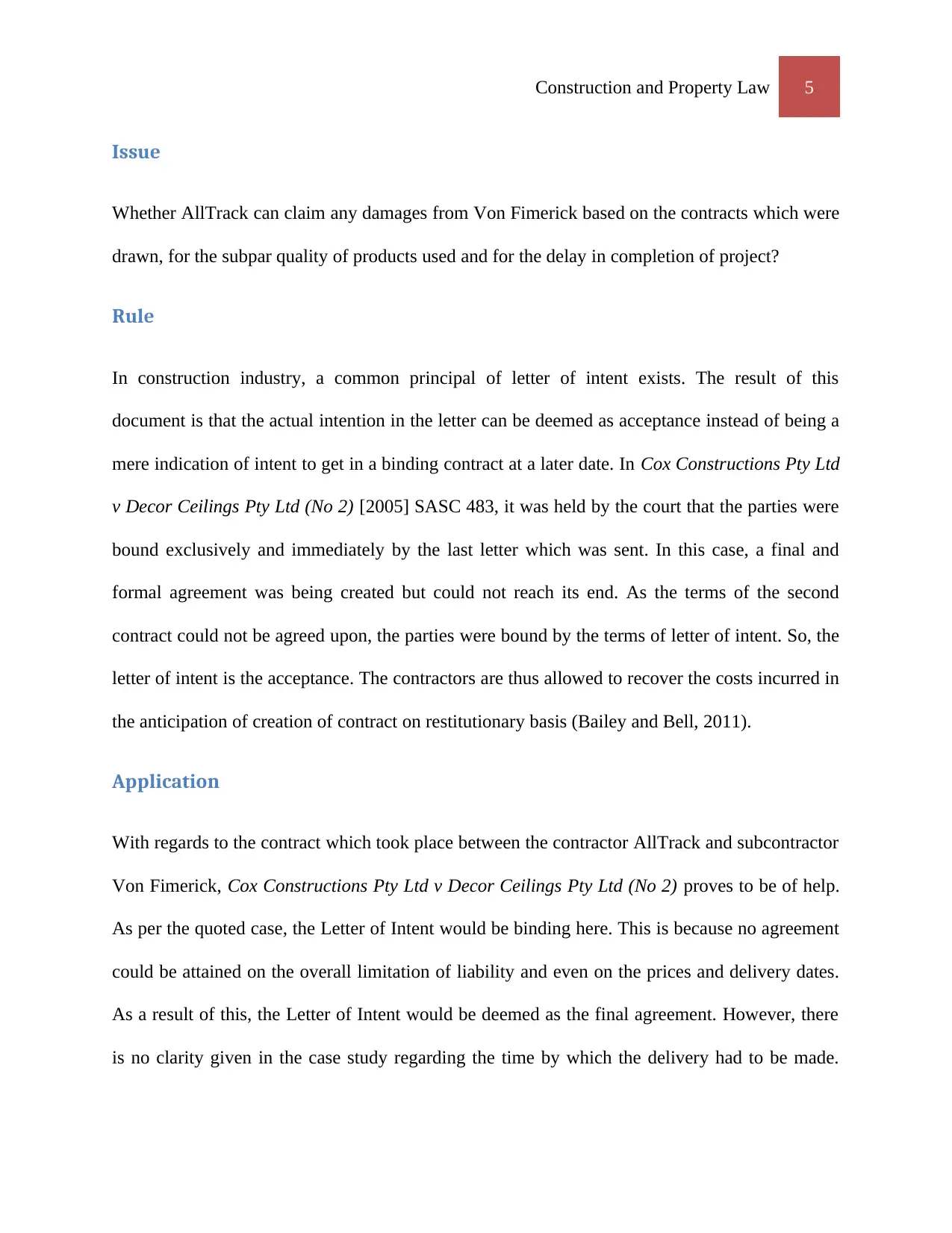
Construction and Property Law 5
Issue
Whether AllTrack can claim any damages from Von Fimerick based on the contracts which were
drawn, for the subpar quality of products used and for the delay in completion of project?
Rule
In construction industry, a common principal of letter of intent exists. The result of this
document is that the actual intention in the letter can be deemed as acceptance instead of being a
mere indication of intent to get in a binding contract at a later date. In Cox Constructions Pty Ltd
v Decor Ceilings Pty Ltd (No 2) [2005] SASC 483, it was held by the court that the parties were
bound exclusively and immediately by the last letter which was sent. In this case, a final and
formal agreement was being created but could not reach its end. As the terms of the second
contract could not be agreed upon, the parties were bound by the terms of letter of intent. So, the
letter of intent is the acceptance. The contractors are thus allowed to recover the costs incurred in
the anticipation of creation of contract on restitutionary basis (Bailey and Bell, 2011).
Application
With regards to the contract which took place between the contractor AllTrack and subcontractor
Von Fimerick, Cox Constructions Pty Ltd v Decor Ceilings Pty Ltd (No 2) proves to be of help.
As per the quoted case, the Letter of Intent would be binding here. This is because no agreement
could be attained on the overall limitation of liability and even on the prices and delivery dates.
As a result of this, the Letter of Intent would be deemed as the final agreement. However, there
is no clarity given in the case study regarding the time by which the delivery had to be made.
Issue
Whether AllTrack can claim any damages from Von Fimerick based on the contracts which were
drawn, for the subpar quality of products used and for the delay in completion of project?
Rule
In construction industry, a common principal of letter of intent exists. The result of this
document is that the actual intention in the letter can be deemed as acceptance instead of being a
mere indication of intent to get in a binding contract at a later date. In Cox Constructions Pty Ltd
v Decor Ceilings Pty Ltd (No 2) [2005] SASC 483, it was held by the court that the parties were
bound exclusively and immediately by the last letter which was sent. In this case, a final and
formal agreement was being created but could not reach its end. As the terms of the second
contract could not be agreed upon, the parties were bound by the terms of letter of intent. So, the
letter of intent is the acceptance. The contractors are thus allowed to recover the costs incurred in
the anticipation of creation of contract on restitutionary basis (Bailey and Bell, 2011).
Application
With regards to the contract which took place between the contractor AllTrack and subcontractor
Von Fimerick, Cox Constructions Pty Ltd v Decor Ceilings Pty Ltd (No 2) proves to be of help.
As per the quoted case, the Letter of Intent would be binding here. This is because no agreement
could be attained on the overall limitation of liability and even on the prices and delivery dates.
As a result of this, the Letter of Intent would be deemed as the final agreement. However, there
is no clarity given in the case study regarding the time by which the delivery had to be made.
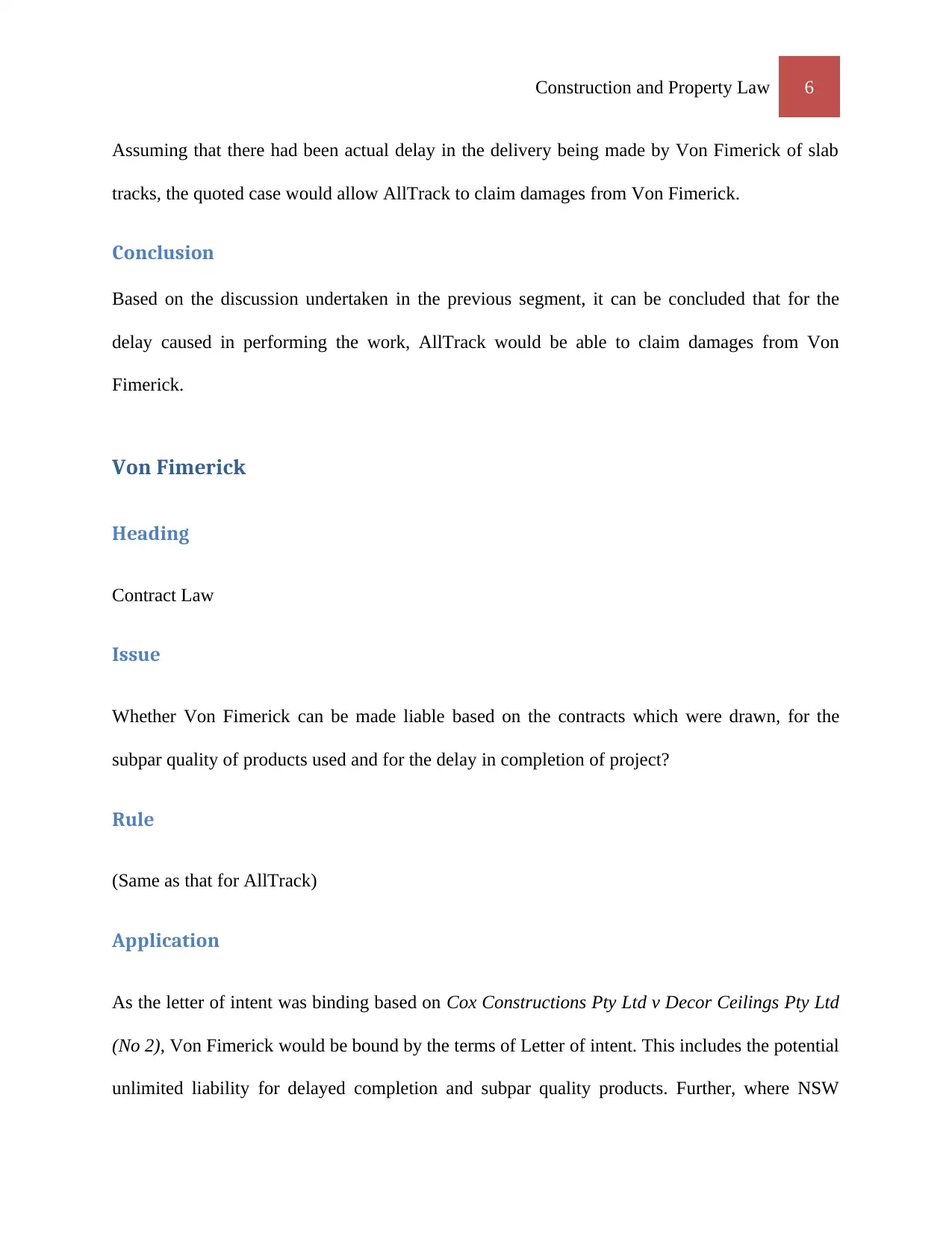
Construction and Property Law 6
Assuming that there had been actual delay in the delivery being made by Von Fimerick of slab
tracks, the quoted case would allow AllTrack to claim damages from Von Fimerick.
Conclusion
Based on the discussion undertaken in the previous segment, it can be concluded that for the
delay caused in performing the work, AllTrack would be able to claim damages from Von
Fimerick.
Von Fimerick
Heading
Contract Law
Issue
Whether Von Fimerick can be made liable based on the contracts which were drawn, for the
subpar quality of products used and for the delay in completion of project?
Rule
(Same as that for AllTrack)
Application
As the letter of intent was binding based on Cox Constructions Pty Ltd v Decor Ceilings Pty Ltd
(No 2), Von Fimerick would be bound by the terms of Letter of intent. This includes the potential
unlimited liability for delayed completion and subpar quality products. Further, where NSW
Assuming that there had been actual delay in the delivery being made by Von Fimerick of slab
tracks, the quoted case would allow AllTrack to claim damages from Von Fimerick.
Conclusion
Based on the discussion undertaken in the previous segment, it can be concluded that for the
delay caused in performing the work, AllTrack would be able to claim damages from Von
Fimerick.
Von Fimerick
Heading
Contract Law
Issue
Whether Von Fimerick can be made liable based on the contracts which were drawn, for the
subpar quality of products used and for the delay in completion of project?
Rule
(Same as that for AllTrack)
Application
As the letter of intent was binding based on Cox Constructions Pty Ltd v Decor Ceilings Pty Ltd
(No 2), Von Fimerick would be bound by the terms of Letter of intent. This includes the potential
unlimited liability for delayed completion and subpar quality products. Further, where NSW
⊘ This is a preview!⊘
Do you want full access?
Subscribe today to unlock all pages.

Trusted by 1+ million students worldwide
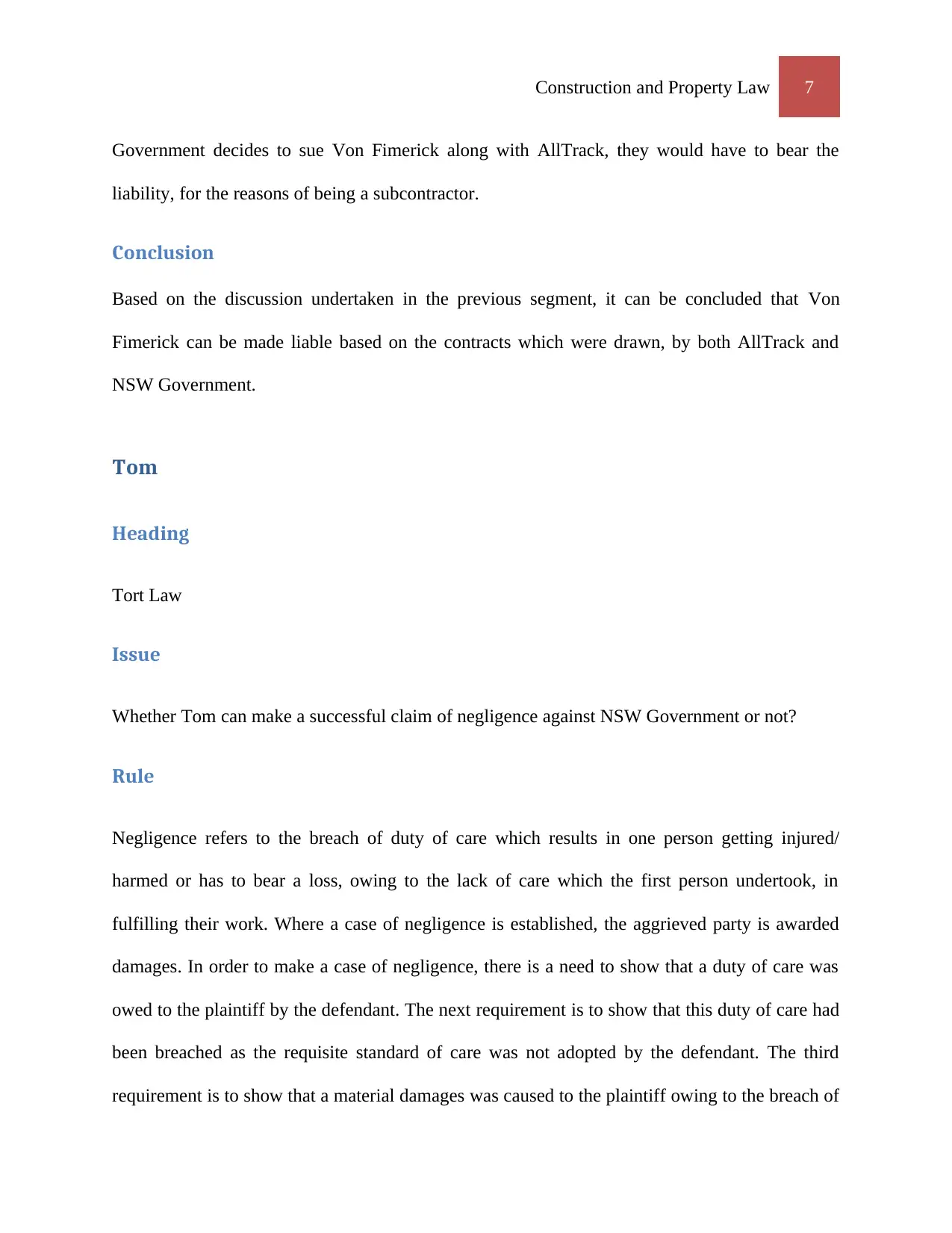
Construction and Property Law 7
Government decides to sue Von Fimerick along with AllTrack, they would have to bear the
liability, for the reasons of being a subcontractor.
Conclusion
Based on the discussion undertaken in the previous segment, it can be concluded that Von
Fimerick can be made liable based on the contracts which were drawn, by both AllTrack and
NSW Government.
Tom
Heading
Tort Law
Issue
Whether Tom can make a successful claim of negligence against NSW Government or not?
Rule
Negligence refers to the breach of duty of care which results in one person getting injured/
harmed or has to bear a loss, owing to the lack of care which the first person undertook, in
fulfilling their work. Where a case of negligence is established, the aggrieved party is awarded
damages. In order to make a case of negligence, there is a need to show that a duty of care was
owed to the plaintiff by the defendant. The next requirement is to show that this duty of care had
been breached as the requisite standard of care was not adopted by the defendant. The third
requirement is to show that a material damages was caused to the plaintiff owing to the breach of
Government decides to sue Von Fimerick along with AllTrack, they would have to bear the
liability, for the reasons of being a subcontractor.
Conclusion
Based on the discussion undertaken in the previous segment, it can be concluded that Von
Fimerick can be made liable based on the contracts which were drawn, by both AllTrack and
NSW Government.
Tom
Heading
Tort Law
Issue
Whether Tom can make a successful claim of negligence against NSW Government or not?
Rule
Negligence refers to the breach of duty of care which results in one person getting injured/
harmed or has to bear a loss, owing to the lack of care which the first person undertook, in
fulfilling their work. Where a case of negligence is established, the aggrieved party is awarded
damages. In order to make a case of negligence, there is a need to show that a duty of care was
owed to the plaintiff by the defendant. The next requirement is to show that this duty of care had
been breached as the requisite standard of care was not adopted by the defendant. The third
requirement is to show that a material damages was caused to the plaintiff owing to the breach of
Paraphrase This Document
Need a fresh take? Get an instant paraphrase of this document with our AI Paraphraser
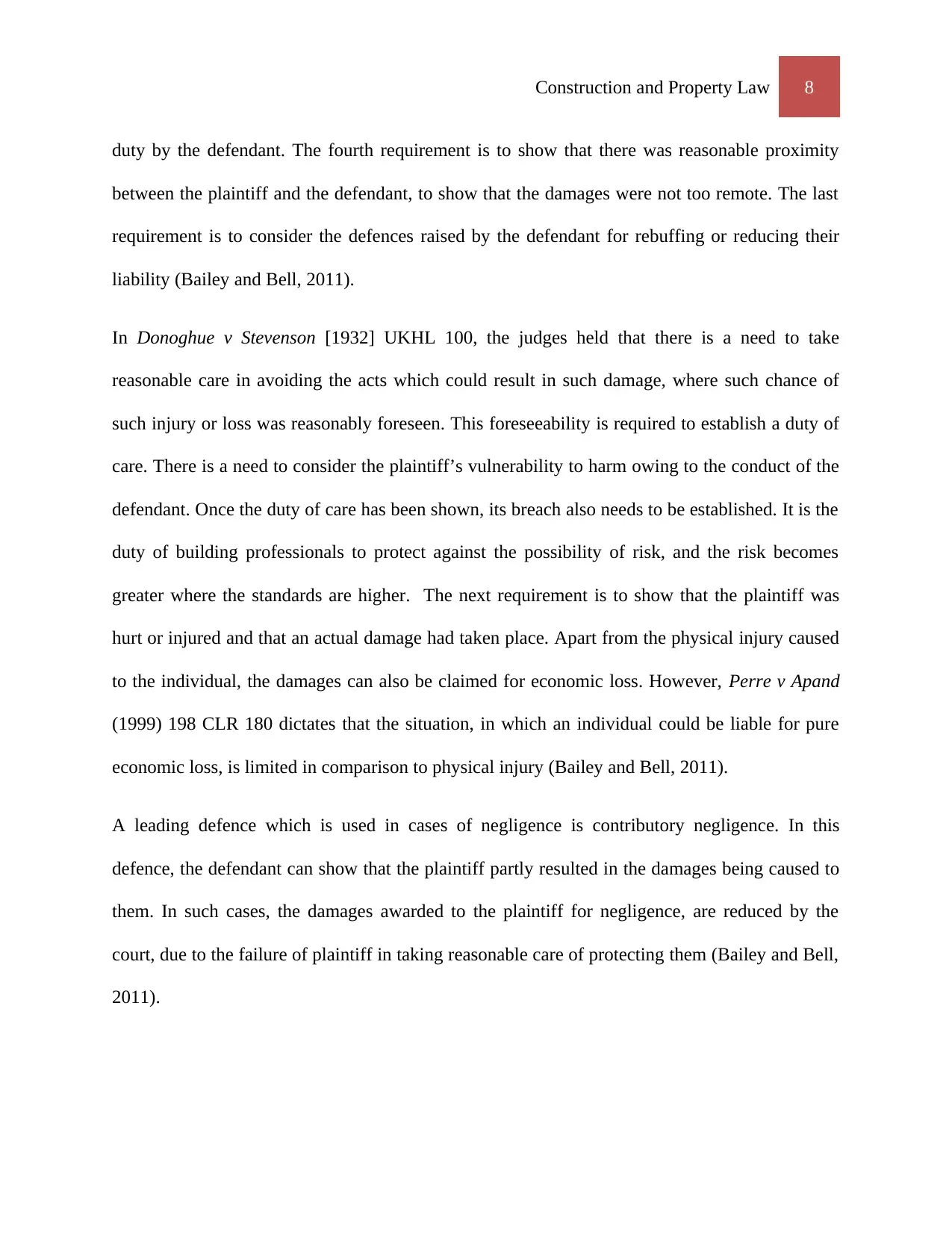
Construction and Property Law 8
duty by the defendant. The fourth requirement is to show that there was reasonable proximity
between the plaintiff and the defendant, to show that the damages were not too remote. The last
requirement is to consider the defences raised by the defendant for rebuffing or reducing their
liability (Bailey and Bell, 2011).
In Donoghue v Stevenson [1932] UKHL 100, the judges held that there is a need to take
reasonable care in avoiding the acts which could result in such damage, where such chance of
such injury or loss was reasonably foreseen. This foreseeability is required to establish a duty of
care. There is a need to consider the plaintiff’s vulnerability to harm owing to the conduct of the
defendant. Once the duty of care has been shown, its breach also needs to be established. It is the
duty of building professionals to protect against the possibility of risk, and the risk becomes
greater where the standards are higher. The next requirement is to show that the plaintiff was
hurt or injured and that an actual damage had taken place. Apart from the physical injury caused
to the individual, the damages can also be claimed for economic loss. However, Perre v Apand
(1999) 198 CLR 180 dictates that the situation, in which an individual could be liable for pure
economic loss, is limited in comparison to physical injury (Bailey and Bell, 2011).
A leading defence which is used in cases of negligence is contributory negligence. In this
defence, the defendant can show that the plaintiff partly resulted in the damages being caused to
them. In such cases, the damages awarded to the plaintiff for negligence, are reduced by the
court, due to the failure of plaintiff in taking reasonable care of protecting them (Bailey and Bell,
2011).
duty by the defendant. The fourth requirement is to show that there was reasonable proximity
between the plaintiff and the defendant, to show that the damages were not too remote. The last
requirement is to consider the defences raised by the defendant for rebuffing or reducing their
liability (Bailey and Bell, 2011).
In Donoghue v Stevenson [1932] UKHL 100, the judges held that there is a need to take
reasonable care in avoiding the acts which could result in such damage, where such chance of
such injury or loss was reasonably foreseen. This foreseeability is required to establish a duty of
care. There is a need to consider the plaintiff’s vulnerability to harm owing to the conduct of the
defendant. Once the duty of care has been shown, its breach also needs to be established. It is the
duty of building professionals to protect against the possibility of risk, and the risk becomes
greater where the standards are higher. The next requirement is to show that the plaintiff was
hurt or injured and that an actual damage had taken place. Apart from the physical injury caused
to the individual, the damages can also be claimed for economic loss. However, Perre v Apand
(1999) 198 CLR 180 dictates that the situation, in which an individual could be liable for pure
economic loss, is limited in comparison to physical injury (Bailey and Bell, 2011).
A leading defence which is used in cases of negligence is contributory negligence. In this
defence, the defendant can show that the plaintiff partly resulted in the damages being caused to
them. In such cases, the damages awarded to the plaintiff for negligence, are reduced by the
court, due to the failure of plaintiff in taking reasonable care of protecting them (Bailey and Bell,
2011).
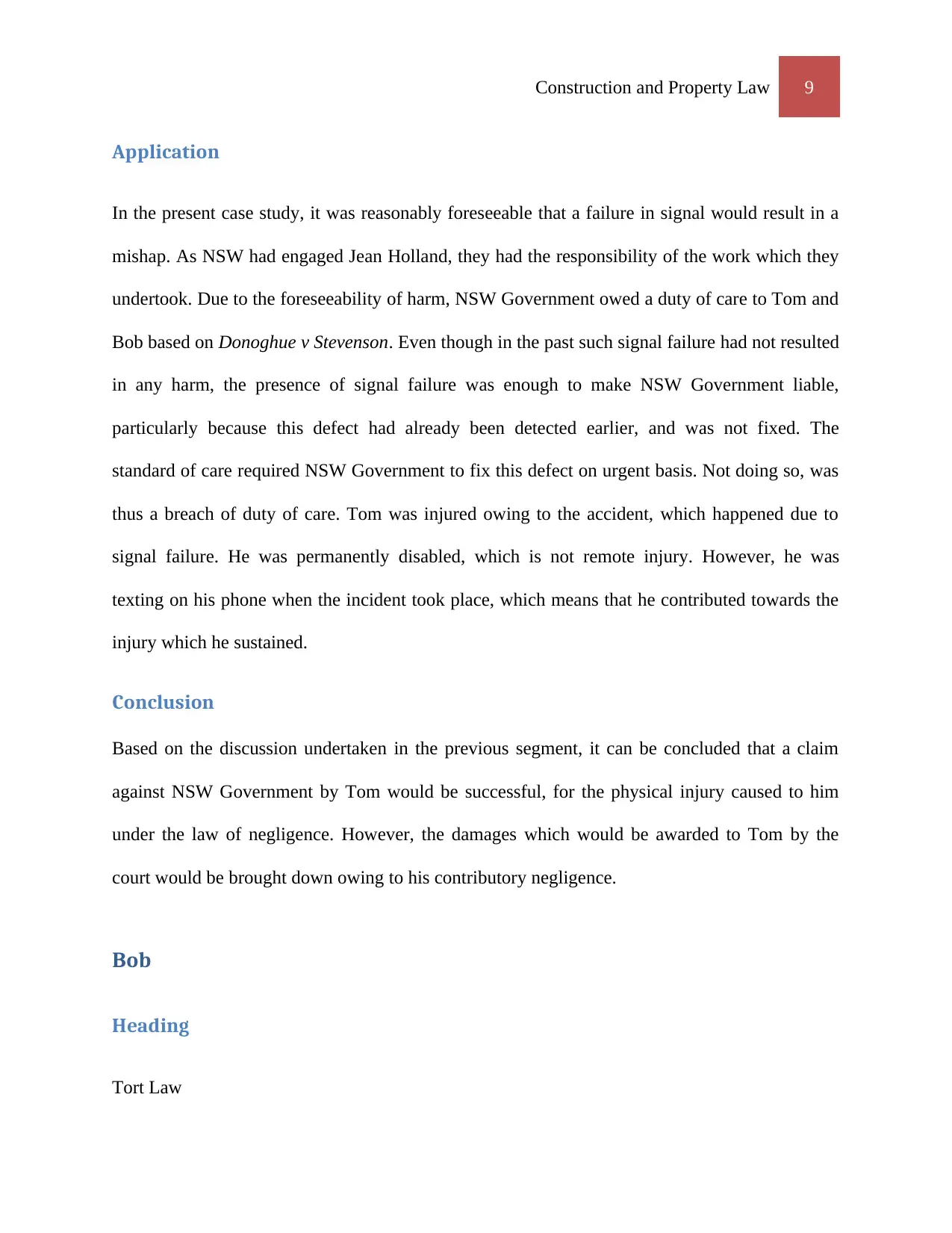
Construction and Property Law 9
Application
In the present case study, it was reasonably foreseeable that a failure in signal would result in a
mishap. As NSW had engaged Jean Holland, they had the responsibility of the work which they
undertook. Due to the foreseeability of harm, NSW Government owed a duty of care to Tom and
Bob based on Donoghue v Stevenson. Even though in the past such signal failure had not resulted
in any harm, the presence of signal failure was enough to make NSW Government liable,
particularly because this defect had already been detected earlier, and was not fixed. The
standard of care required NSW Government to fix this defect on urgent basis. Not doing so, was
thus a breach of duty of care. Tom was injured owing to the accident, which happened due to
signal failure. He was permanently disabled, which is not remote injury. However, he was
texting on his phone when the incident took place, which means that he contributed towards the
injury which he sustained.
Conclusion
Based on the discussion undertaken in the previous segment, it can be concluded that a claim
against NSW Government by Tom would be successful, for the physical injury caused to him
under the law of negligence. However, the damages which would be awarded to Tom by the
court would be brought down owing to his contributory negligence.
Bob
Heading
Tort Law
Application
In the present case study, it was reasonably foreseeable that a failure in signal would result in a
mishap. As NSW had engaged Jean Holland, they had the responsibility of the work which they
undertook. Due to the foreseeability of harm, NSW Government owed a duty of care to Tom and
Bob based on Donoghue v Stevenson. Even though in the past such signal failure had not resulted
in any harm, the presence of signal failure was enough to make NSW Government liable,
particularly because this defect had already been detected earlier, and was not fixed. The
standard of care required NSW Government to fix this defect on urgent basis. Not doing so, was
thus a breach of duty of care. Tom was injured owing to the accident, which happened due to
signal failure. He was permanently disabled, which is not remote injury. However, he was
texting on his phone when the incident took place, which means that he contributed towards the
injury which he sustained.
Conclusion
Based on the discussion undertaken in the previous segment, it can be concluded that a claim
against NSW Government by Tom would be successful, for the physical injury caused to him
under the law of negligence. However, the damages which would be awarded to Tom by the
court would be brought down owing to his contributory negligence.
Bob
Heading
Tort Law
⊘ This is a preview!⊘
Do you want full access?
Subscribe today to unlock all pages.

Trusted by 1+ million students worldwide
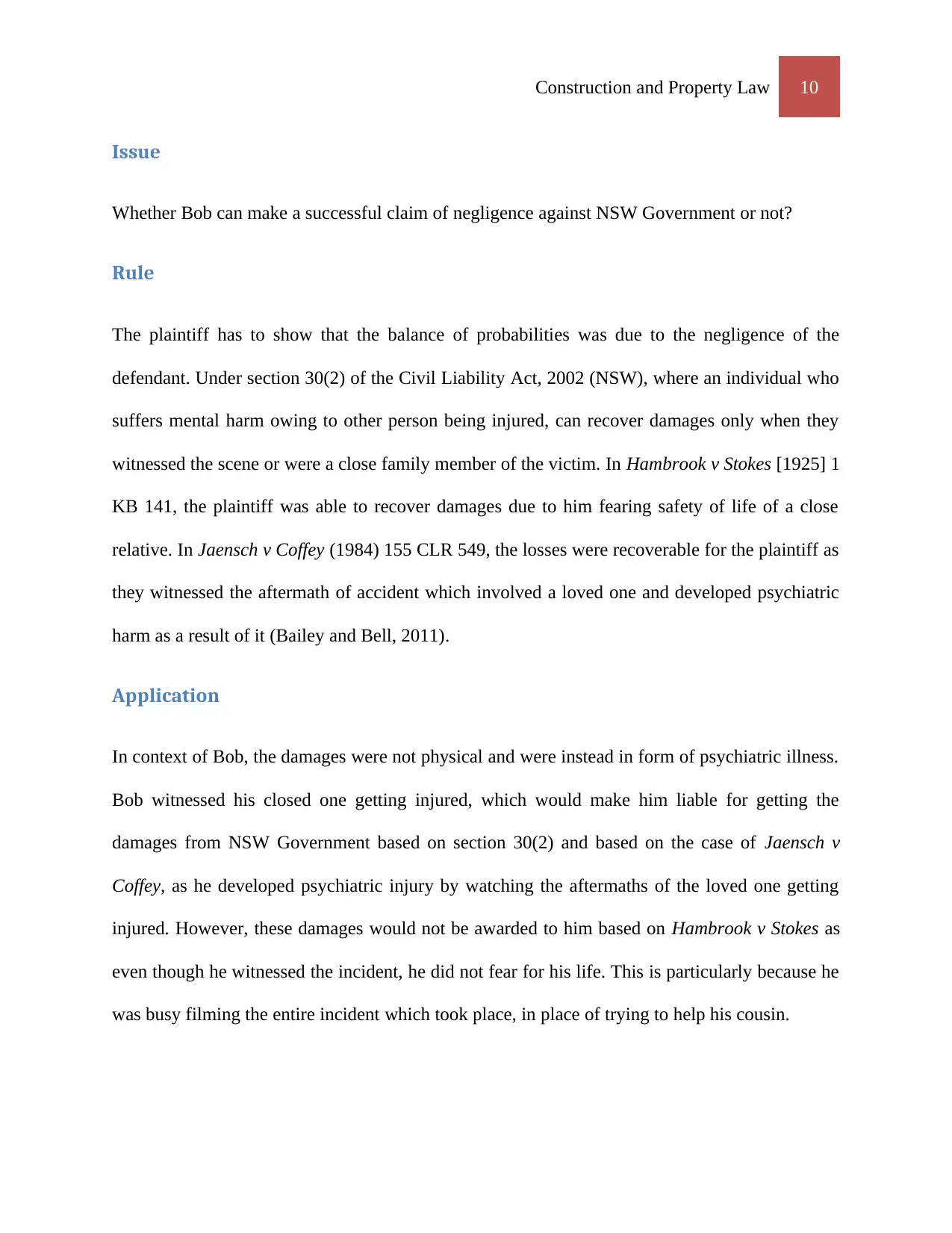
Construction and Property Law 10
Issue
Whether Bob can make a successful claim of negligence against NSW Government or not?
Rule
The plaintiff has to show that the balance of probabilities was due to the negligence of the
defendant. Under section 30(2) of the Civil Liability Act, 2002 (NSW), where an individual who
suffers mental harm owing to other person being injured, can recover damages only when they
witnessed the scene or were a close family member of the victim. In Hambrook v Stokes [1925] 1
KB 141, the plaintiff was able to recover damages due to him fearing safety of life of a close
relative. In Jaensch v Coffey (1984) 155 CLR 549, the losses were recoverable for the plaintiff as
they witnessed the aftermath of accident which involved a loved one and developed psychiatric
harm as a result of it (Bailey and Bell, 2011).
Application
In context of Bob, the damages were not physical and were instead in form of psychiatric illness.
Bob witnessed his closed one getting injured, which would make him liable for getting the
damages from NSW Government based on section 30(2) and based on the case of Jaensch v
Coffey, as he developed psychiatric injury by watching the aftermaths of the loved one getting
injured. However, these damages would not be awarded to him based on Hambrook v Stokes as
even though he witnessed the incident, he did not fear for his life. This is particularly because he
was busy filming the entire incident which took place, in place of trying to help his cousin.
Issue
Whether Bob can make a successful claim of negligence against NSW Government or not?
Rule
The plaintiff has to show that the balance of probabilities was due to the negligence of the
defendant. Under section 30(2) of the Civil Liability Act, 2002 (NSW), where an individual who
suffers mental harm owing to other person being injured, can recover damages only when they
witnessed the scene or were a close family member of the victim. In Hambrook v Stokes [1925] 1
KB 141, the plaintiff was able to recover damages due to him fearing safety of life of a close
relative. In Jaensch v Coffey (1984) 155 CLR 549, the losses were recoverable for the plaintiff as
they witnessed the aftermath of accident which involved a loved one and developed psychiatric
harm as a result of it (Bailey and Bell, 2011).
Application
In context of Bob, the damages were not physical and were instead in form of psychiatric illness.
Bob witnessed his closed one getting injured, which would make him liable for getting the
damages from NSW Government based on section 30(2) and based on the case of Jaensch v
Coffey, as he developed psychiatric injury by watching the aftermaths of the loved one getting
injured. However, these damages would not be awarded to him based on Hambrook v Stokes as
even though he witnessed the incident, he did not fear for his life. This is particularly because he
was busy filming the entire incident which took place, in place of trying to help his cousin.
Paraphrase This Document
Need a fresh take? Get an instant paraphrase of this document with our AI Paraphraser
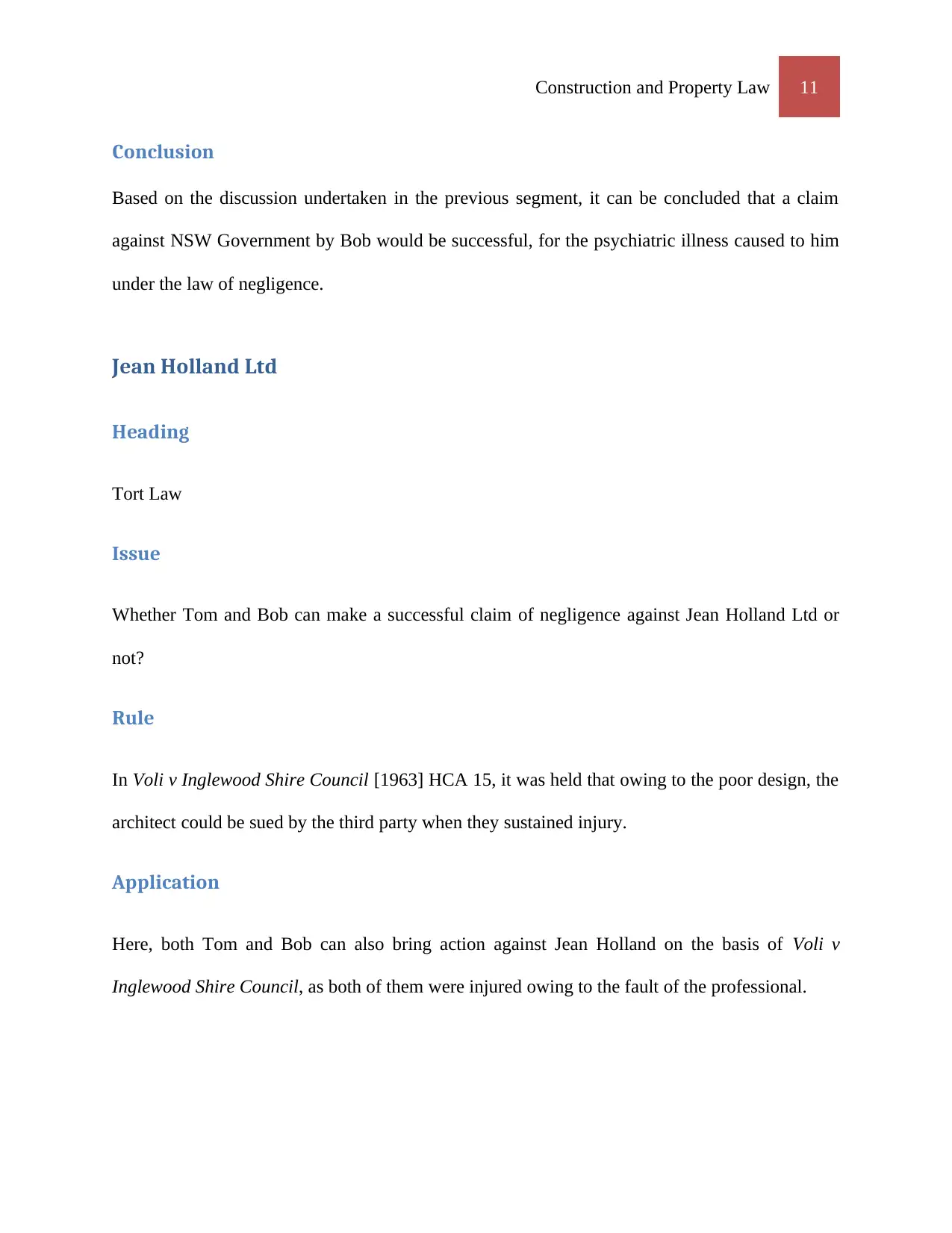
Construction and Property Law 11
Conclusion
Based on the discussion undertaken in the previous segment, it can be concluded that a claim
against NSW Government by Bob would be successful, for the psychiatric illness caused to him
under the law of negligence.
Jean Holland Ltd
Heading
Tort Law
Issue
Whether Tom and Bob can make a successful claim of negligence against Jean Holland Ltd or
not?
Rule
In Voli v Inglewood Shire Council [1963] HCA 15, it was held that owing to the poor design, the
architect could be sued by the third party when they sustained injury.
Application
Here, both Tom and Bob can also bring action against Jean Holland on the basis of Voli v
Inglewood Shire Council, as both of them were injured owing to the fault of the professional.
Conclusion
Based on the discussion undertaken in the previous segment, it can be concluded that a claim
against NSW Government by Bob would be successful, for the psychiatric illness caused to him
under the law of negligence.
Jean Holland Ltd
Heading
Tort Law
Issue
Whether Tom and Bob can make a successful claim of negligence against Jean Holland Ltd or
not?
Rule
In Voli v Inglewood Shire Council [1963] HCA 15, it was held that owing to the poor design, the
architect could be sued by the third party when they sustained injury.
Application
Here, both Tom and Bob can also bring action against Jean Holland on the basis of Voli v
Inglewood Shire Council, as both of them were injured owing to the fault of the professional.

Construction and Property Law 12
Conclusion
Based on the discussion undertaken in the previous segment, it can be concluded that Tom and
Bob can also make the same claims against Jean Holland and would be successful.
Conclusion
Based on the discussion undertaken in the previous segment, it can be concluded that Tom and
Bob can also make the same claims against Jean Holland and would be successful.
⊘ This is a preview!⊘
Do you want full access?
Subscribe today to unlock all pages.

Trusted by 1+ million students worldwide
1 out of 13
Your All-in-One AI-Powered Toolkit for Academic Success.
+13062052269
info@desklib.com
Available 24*7 on WhatsApp / Email
![[object Object]](/_next/static/media/star-bottom.7253800d.svg)
Unlock your academic potential
Copyright © 2020–2025 A2Z Services. All Rights Reserved. Developed and managed by ZUCOL.
